New York Jewish Film Festival 2016: Interviews
Rabin, The Last Day, Lamb, and Hot Sugar’s Cold World will screen in the 25th annual New York Jewish Film Festival, co-presented with the Jewish Museum and running from January 13 to 26.
Postmortem: Rabin, The Last Day
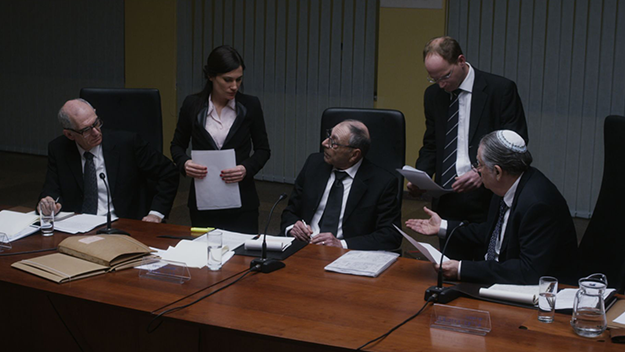
In the interview preamble to Amos Gitai’s Rabin, The Last Day, a solemn Shimon Peres recalls the memory of his friend, former Israeli Prime Minister Yitzhak Rabin—then the subject of vicious censure for the Oslo Accords of 1994—and his utter fearlessness in the face of opprobrium. “Rabin went through a very difficult time before he was assassinated,” Peres notes. “That’s when I admired him most. They spat at him, shouted at him, swore at him . . . And he carried on.”
Twenty years later, Rabin’s assassination at a 1995 rally by extremist Yigal Amir has come to signify one of history’s great missed opportunities for peace. In its careful tapestry of archival footage and dramatization, Rabin, The Last Day spirits us briefly back to this more hopeful time, when peace was not so remote. “We are still now living in the wake of Amir’s act,” Gitai told FILM COMMENT in an interview. “But the end is not written.”
Though the facts of Rabin’s killing are widely known, Gitai’s prismatic, rigorous use of its witnesses accrues a Rashomon-like force. Dramatizing the proceedings of the Shamgar Commission, tasked with reconstructing the event, Gitai presents Rabin’s driver, his bodyguard, and his doctor, each eager to finger-point. How could the route to Ichilov Hospital, a 500-meter distance, have taken eight minutes to drive? Where was security—and why were rallygoers not screened? How did the doctors fail to save him? Rabin, The Last Day uses these many voices to keep us from losing perspective in a sea of particulars.
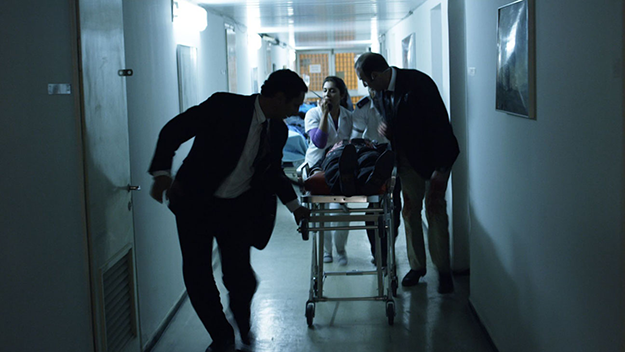
“It was a coup d’état. It exploded Israeli society. The only way to approach it in film was to explode the normal structure of film,” Gitai said. “To start with Peres, see the assassination, then move backward and forward in time.” We view Rabin burned in effigy, subjected to death-spells, diagnosed as schizoid, likened to Petain. We meet a wily and evasive Yigal Amir (a formidable Yogev Yefet), who deliriously claims to have sacrificed himself for Israel. What emerges is a strange vertigo, a desire to divert and salvage the past, to splice the film anew.
The film closes with an affecting interview with Rabin’s wife, Leah, confiding through tears that she never contemplated such an “insane, cruel, incomprehensible” act might actually happen. “I can’t even get angry,” she says. “There’s no anger in me. It’s beyond me . . . I can only feel sorrow.” Rabin: The Last Day wisely eschews final visions of truth or understanding. The true work of peacekeeping, Gitai implies, is patience, the slow cultivation of possibility. Political “solutions” are never thus, but rather provisional, open, necessarily incomplete. At the end, Shamgar, his commission closed, emerges into the rain-wet street, and the shambolic, hopeful din of life.
Animal Instincts: Lamb
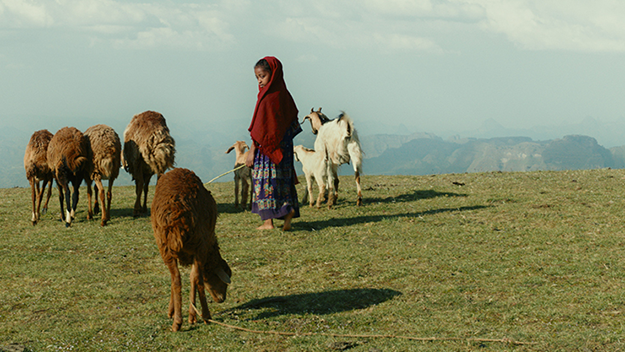
“There’s too much cliché about Africa,” Yared Zeleke, the writer-director of Lamb, the first Ethiopian film to screen at Cannes, told FILM COMMENT. “I wanted to play with the idea of Africa in film.”
Though it borrows stray cues from The Apu Trilogy and Au hasard Balthasar, Lamb, Zeleke’s assured debut feature, a tender portrait of a child in extremis, emerges as a new voice, one of naked originality. Capturing life through the whimsical mind of a 9-year-old boy, Ephraim (Radiat Amare), Lamb follows its hero as his life explodes in the wake of his mother’s passing—driven from home, foisted on distant relatives, and forced to make sense of his vaporized world.
“It’s a coming-of-age story, a mixture between fable and realism,” Zeleke said. “Its heart is the internal aspect of Ephraim’s vision. There is no good and evil, only everything in-between.”
No mere tale of youth and adulthood, Zeleke locates universals in the particular of Ephraim’s story, and his lost love, rebellion, and ultimate freedom. Asked to sacrifice his beloved lamb Chuni for an upcoming family celebration (one to whom he has promised “We’ll never part”), and facing withering menace at home (labeled a “starving hick” by peers, and “effeminate” by his uncle Solomon), Ephraim takes flight to magical mountains and forbidden forests, all the while confiding in Chuni, his best and only friend. While explicit connections are made between Ephraim and the lamb, their innocence and sacrifice, the quieter revelation of the film is that we never leave such states of unsophistication, ambling and careening into adulthood, fooling ourselves that we’ve made sense of the universe.
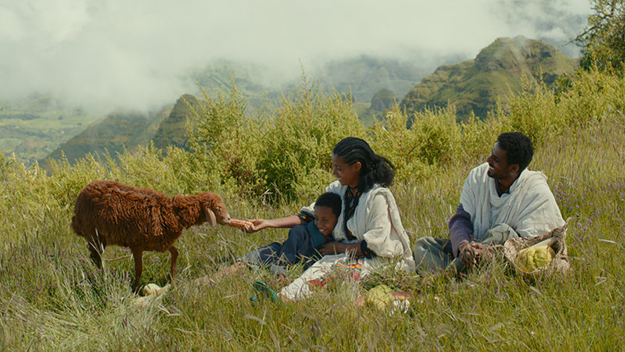
Zeleke grew up in Addis Ababa under The Derg (Ethiopia’s ruling junta from 1974 to 1987), and his film partly draws upon his memories. Raised in Ethiopia by his grandmother, Zeleke lived in the U.S. and Norway, ultimately returning to New York to obtain his MFA at NYU-Tisch. “I felt guilty for having survived,” he said. At Tisch he was encouraged by his writing teacher—the director Todd Solondz—to turn his idea into a full-length script. For Zeleke, offering an authentic and personal Ethiopian film was a task unto itself.
“Ethiopia’s cinema is still in its early stages. We are a mountain people, the size of two Texases,” Zeleke said. “We were never colonized. Our culture survived intact, a time capsule. It’s like a fairy tale. There is a debt to that tradition.”
Shooting in the Bale Mountains, Zeleke and DP José Deshaies (Saint Laurent) fill Lamb with vistas both breathtaking and novel—raucous celebrations, crimson shawls and teal veldts. Predictably, the film’s beastly co-star proved less cooperative, as did other fauna. “Chuni [the lamb] was a huge troublemaker,” said Zeleke. “He ate a cake that was crew’s lunch. I didn’t even know they ate sweets. We had problems with bulls, horses, the bird. There was no animal wrangler.”
Zeleke’s investment in Ethiopian cinema is far from complete. For his next project, a film tentatively titled 1991, Zeleke hopes to take on the fall of Communism in Ethiopia, another personal tale. “Lamb was about boyhood; what feels natural is to do my next film on the youth. The majority of Ethiopia’s population is under 30. These will be the people that will shape the future.”
Now Hear This: Hot Sugar’s Cold World
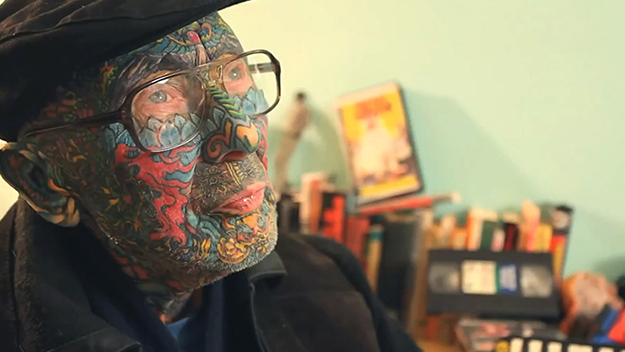
“From the beginning, I wanted to use different sounds,” a chipper, droopy-eyed Nick Koenig (aka Hot Sugar) tells us in Adam Bhala Lough’s new documentary. Soon, we are treated to the sound and vision of Pop Rocks poured into the mouth of friend Rachel Trachtenburg, the scuff of shoveled snow, the wheeze of assailed trash bags. For Sugar, an acolyte of the Associative Music movement—practically a Dogme95-grade code of audio purity—music en plein air is a rite, less a feat of composition than discovery. Why borrow a synth when you can make one yourself?
Cold World follows Sugar burning dollhouses, grinding metal plates, banging skulls in Parisian catacombs, stroking Beanie babies, and painstakingly transmuting it all into effulgent, 8-bit, ballerina-box twinkle. The menu of found-sound goes on: ants crawling on cocaine; bats; blood from a virgin; a cat with trouble breathing. If you’ve ever wondered what a field of Italian marijuana sounds like, Hot Sugar will provide. “Recording sounds is the closest thing I get to having control over anything in my life,” Koenig explains at one point. “You can take a stock synth and play with knobs and tweak it, but you can’t replicate drums that I recorded in Times Square at 2 a.m. when a cab was honking and someone was throwing up 10 feet away from me. It’s going to sound like nothing else.”
Weaving together interviews with Sugar and friends, music-doc veteran Lough (The Upsetter, The Carter) paints a lived-in portrait of the peripatetic flower child. We are privy to beat-making with Jim Jarmusch (“Don’t let ?uestlove hear that”), firecracker-lighting with Martin Starr (“What are you celebrating?” “We’re celebrating life”), music physics with Neil DeGrasse Tyson, and intimate moments with Koenig’s girlfriend, rapper Kitty—a love quickly foundering under the weight of jealousy and career. All are intercut with Sugar’s dewy and discursive musings on life, his innocent surprise at his fellow humans’ lack of wonder. Visiting the two-story organ in Notre Dame Cathedral, he notes: “[The programmer] plays the same four songs. But like no one ever plays Eve’s ‘Who’s That Girl?’, or any Ruff Ryders, frankly.”
For all of its subject’s aw-shucks insouciance, Hot Sugar’s Cold World reacquaints us with a childlike awe and reverence in the discovery of sound. “Anything can be turned into an instrument,” Sugar says. It’s merely a matter of play.



